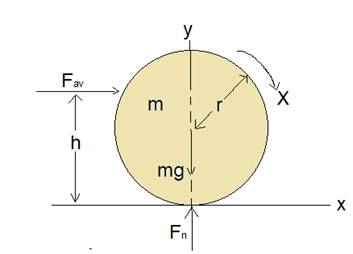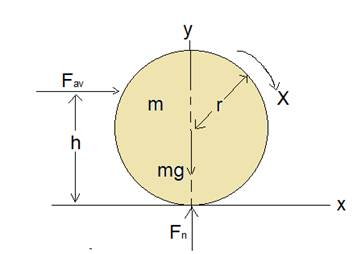
Concept explainers
(a)
The speed of the ball just after impact.
(a)
Answer to Problem 104P
Explanation of Solution
Given:
Mass of a uniform solid ball =
Radius of the ball =
The height above the horizontal surface at which the force is applied on the ball,
During the impact, the force (F) increases from
Therefore, average force,
Formula used:
Applying impulse-momentum theorem to the ball,
Where
Calculation:

FIGURE:
Substituting numerical values in equation
Conclusion:
The speed of the ball just after impact is
(b)
The angular speed of the ball after impact.
(b)
Answer to Problem 104P
Explanation of Solution
Given:
Mass of a uniform solid ball =
Radius of the ball =
The height above the horizontal surface at which the force is applied on the ball,
During the impact, the force (F) increases from
Therefore, average force,
Formula used:
Applying Newton’s second law in rotational form to ball,
Where,
Moment of inertia with respect to an axis through the center of mass of the ball is
Substituting this in equation
From equation
Substituting the expression for
Calculation:

FIGURE: 2
Substituting the numerical values in equation
Conclusion:
The angular speed of the ball after impact is
(c)
The speed of the ball when it begins to roll without slipping.
(c)
Answer to Problem 104P
Explanation of Solution
Given:
Mass of a uniform solid ball =
Radius of the ball =
The height above the horizontal surface at which the force is applied on the ball,
During the impact, the force (F) increases from
Therefore, average force,
Coefficient of kinetic friction,
Formula used:
Constant acceleration equation that relates the speed of the ball to the acceleration and time,
Where,
Referring to the force diagram shown in figure 3, applying Newton’s second law to the ball,
And
Where,
But,
Where,
From equation
Substituting this in equation
Substituting the expression for
Substituting
From equation
Substituting for
Now let us write constant-acceleration equation that connects angular speed of the ball to the angular acceleration and time,
When the ball rolls without slipping
From equation
Hence,
Now equating the expressions
On rearranging,
Calculation:

FIGURE:3
Substituting the numerical values in equation
Substituting the numerical values in equation
Conclusion:
The speed of the ball when it begins to roll without slipping is
(d)
The distance travelled by the ball along the surface before it begins to roll without slipping.
(d)
Answer to Problem 104P
Explanation of Solution
Given: Coefficient of kinetic friction,
Formula used:
The distance travelled by the ball in time
Since,
Where,
Calculation:

FIGURE: 4
From the part
Substituting the numerical values in equation
Conclusion:
The distance travelled by the ball along the surface before it begins to roll without slipping is
Want to see more full solutions like this?
Chapter 9 Solutions
Physics for Scientists and Engineers
- In Figure P10.40, the hanging object has a mass of m1 = 0.420 kg; the sliding block has a mass of m2 = 0.850 kg; and the pulley is a hollow cylinder with a mass of M = 0.350 kg, an inner radius of R1 = 0.020 0 m, and an outer radius of R2 = 0.030 0 m. Assume the mass of the spokes is negligible. The coefficient of kinetic friction between the block and the horizontal surface is k = 0.250. The pulley turns without friction on its axle. The light cord does not stretch and does not slip on the pulley. The block has a velocity of vi = 0.820 m/s toward the pulley when it passes a reference point on the table. (a) Use energy methods to predict its speed after it has moved to a second point, 0.700 m away. (b) Find the angular speed of the pulley at the same moment. Figure P10.40arrow_forwardFind the net torque on the wheel in Figure P10.23 about the axle through O, taking a = 10.0 cm and b = 25.0 cm. Figure P10.23arrow_forwardConsider the disk in Problem 71. The disks outer rim hasradius R = 4.20 m, and F1 = 10.5 N. Find the magnitude ofeach torque exerted around the center of the disk. FIGURE P12.71 Problems 71-75arrow_forward
- A solid cube of wood of side 2a and mass M is resting on a horizontal surface. The cube is constrained to rotate about a fixed axis AB (Fig. P11.48). A bullet of mass m and speed v is shot at the face opposite ABCD at a height of 4a/3. The bullet becomes embedded in the cube. Find the minimum value of v required to tip the cube so that it falls on face ABCD. Assume m M. Figure P11.48arrow_forwardA homogeneous board weighing 274 N and long L = 6.23 m rests on a wall of height h = 2.87, the upper corner of which has a frictionless rolling mechanism. The plate is in equilibrium for any theta angle greater than or equal to 68.0 °, but it slides as soon as the angle is less than 68.0 °.Find the coefficient of static friction between the board and the floor.arrow_forwardA uniform rod has a mass of 5.0 kg and a length of 2.0 m. At one end is attached a small 3.0 kg mass, and at the other end is a small 1.0 kg mass. How far from the 3.0 kg mass is the center of mass of the system?arrow_forward
- As shown in the figure below, a stick of length L = 0.410 m and mass m = 0.180 kg is in contact with a rough floor at one end and a frictionless bowling ball (diameter d = 20.00 cm) at some other point such that the angle between the stick and the floor is ? = 30°.Determine the following. (a) magnitude of the force exerted on the stick by the bowling ball N(b) horizontal component of the force exerted on the stick by the floor N(c) vertical component of the force exerted on the stick by the floor Narrow_forwardA spade is modelled as a uniform rod, of mass 2kg and length 90cm, attached to a uniform square lamina, of side 20cm and mass 0.5kg. A gardener holds the spade horizontally with hands 30cm and 60cm from the end of the rod. Find the vertical forces exerted by the gardener's hands. Im stuck on this q, pls help.arrow_forwardIn the figure, what magnitude of force F→ applied horizontally at the axle of the wheel is necessary to raise the wheel over an obstacle of height h = 0.284 m? The wheel's radius is r = 0.685 m and its mass is m = 1.50 kg.arrow_forward
- In the figure below, the hanging object has a mass of m1 = 0.350 kg; the sliding block has a mass of m2 = 0.780 kg; and the pulley is a hollow cylinder with a mass of M = 0.350 kg, an inner radius of R1 = 0.020 0 m, and an outer radius of R2 = 0.030 0 m. Assume the mass of the spokes is negligible. The coefficient of kinetic friction between the block and the horizontal surface is μk = 0.250. The pulley turns without friction on its axle. The light cord does not stretch and does not slip on the pulley. The block has a velocity of vi = 0.820 m/s toward the pulley when it passes a reference point on the table. (a) Use energy methods to predict its speed after it has moved to a second point, 0.700 m away. m/s(b) Find the angular speed of the pulley at the same moment. rad/sarrow_forwardA uniform beam of length 3 meters and mass 10 kilograms is balanced horizontally on a pivot point. A weight of 20 newtons is attached to one end of the beam. What is the torque exerted on the beam by the weight? (Assume the weight is attached at the very end of the beam and gravity acts vertically downward.) A) 30 N·m B) 60 N·m C) 20 N·m D) 10 N·marrow_forwardCalculate the m.і. of a thin uniform rod of the mass 100g and length 60cm about an axis perpendicular to its length and passing through (1) its centre and (2) one end.arrow_forward
 Physics for Scientists and Engineers with Modern ...PhysicsISBN:9781337553292Author:Raymond A. Serway, John W. JewettPublisher:Cengage Learning
Physics for Scientists and Engineers with Modern ...PhysicsISBN:9781337553292Author:Raymond A. Serway, John W. JewettPublisher:Cengage Learning Principles of Physics: A Calculus-Based TextPhysicsISBN:9781133104261Author:Raymond A. Serway, John W. JewettPublisher:Cengage Learning
Principles of Physics: A Calculus-Based TextPhysicsISBN:9781133104261Author:Raymond A. Serway, John W. JewettPublisher:Cengage Learning Physics for Scientists and Engineers, Technology ...PhysicsISBN:9781305116399Author:Raymond A. Serway, John W. JewettPublisher:Cengage Learning
Physics for Scientists and Engineers, Technology ...PhysicsISBN:9781305116399Author:Raymond A. Serway, John W. JewettPublisher:Cengage Learning Physics for Scientists and Engineers: Foundations...PhysicsISBN:9781133939146Author:Katz, Debora M.Publisher:Cengage Learning
Physics for Scientists and Engineers: Foundations...PhysicsISBN:9781133939146Author:Katz, Debora M.Publisher:Cengage Learning



